Louisiana, with its humid, subtropical environment, is a thriving habitat for approximately 15 distinct lizard species. Known for its rich wildlife, Louisiana hosts about 140 amphibians and reptiles, among which lizards constitute an essential component of the state’s vibrant ecosystem.
Identification of the different lizards in Louisiana can be achieved by considering factors like their geographical location, appearance, and behavior. In the following sections, we’ll delve into the fascinating world of Louisiana lizards, providing valuable insights about these intriguing creatures. While the state is currently home to 15 species, human activity may lead to the introduction of new species to the area, making the study of these reptiles an ever-evolving field.
Table of Contents
Lizards in Louisiana
1. Green Anole
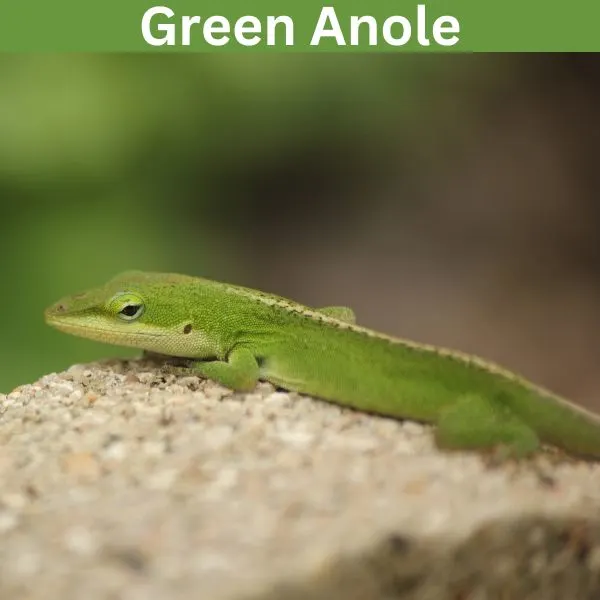
- Experience Level: Beginner
- Family: Dactyloidae
- Scientific Name: Anolis carolinensis
- Other Names: American anole, Red-throated anole
- Adult Size: 5 to 8 in. (12.7 to 20.32 cm.)
- Lifespan: 5 to 8 years
- Average Price Range: $10
Green anoles have been found in most of Louisiana’s counties, and are one of the most common lizards in the state. They are the only native anole species in the state. Green anoles prefer habitats that are humid and have lots of trees. Green anoles are active during the day, seen often basking on fence posts or walls.
This lizard’s head is narrow, and its body slender. They have a long tail, sometimes growing more than their body length. Green anoles vary from green to brownish-gray.
The warmer months of the year are when green anoles lizards breed, and males spend this period looking for a mate. Males have bright dewlaps under their chins, used to attract females for mating. In a breeding period, females lay up to 18 eggs, laying them one at a time. Their eggs are small, white, and may have brown speckles.
The spring and fall months in the state are when this green lizard is active the most. Green anoles enjoy climbing and spend large portions of their lives in trees. In cooler times of the year, green anoles may hide in secluded and cool areas like logs. Spiders, insects, and other invertebrates are what green anoles eat and forage for while active.
2. Brown Anole

- Experience Level: Beginner
- Family: Dactyloidae
- Scientific Name: Anolis sagrei
- Other Names: Bahaman Anole, Cuban Brown Anole
- Adult Size: 5 to 9 in. (12 to 22.86 cm)
- Lifespan: 5 years
- Average Price Range: $10
The brown anole is not a native lizard species to Louisiana, but they are still found within the state. Summer is when this lizard species is active most in the state, and yearly residents of the state report seeing plenty of this brown lizard. Brown anoles’ quick reproduction rate is one of the reasons they have managed to build populations in Louisiana.
Brown anoles have brown or grayish coloring. White or yellow speckles appear on their body. Their coloring helps them blend into surfaces like trees. Males have brightly colored dewlaps which help them attract mates.
Places with lots of trees, and rocks are where brown anoles live. They spend more of their time closer to the ground. Brown anoles are native to Cuba, and the Bahamas, and their introduction to the United States date back to the 1970s.
3. Slender Glass Lizard
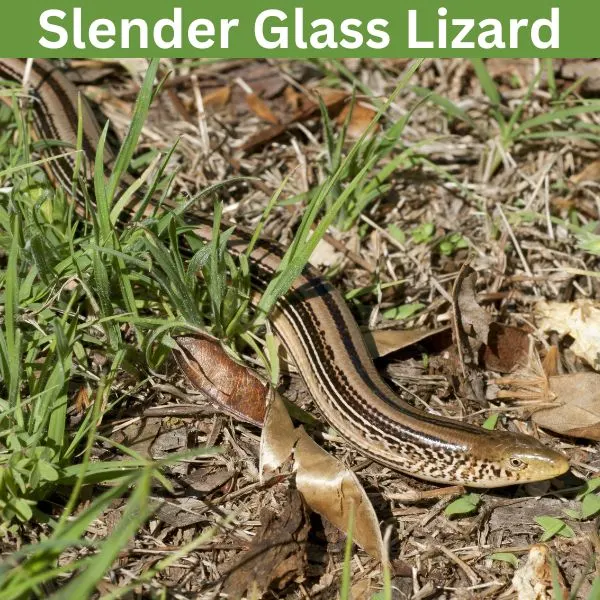
- Experience Level: Intermediate
- Family: Anguidae
- Scientific Name: Ophisaurus attenuatus
- Other Names: n/a
- Adult Size: 22 to 46 in. (55.88 to 116.84 cm.)
- Lifespan: 10 to 30 years
- Average Price Range: $50
The slender glass lizard is one of the two species of legless lizards that inhabit Louisiana. Dry grasslands and woodlands are where this species is found. They are terrestrial and are often confused for snakes because of their limbless bodies, and snake-like shape.
Slender glass lizards on average grow to be about 36 inches. They have smooth skin, and range from tan to yellow coloring. Broad stripes run down their backs, and they may also be coated with a coat of white specks.
Small insects, spiders, and other smaller animals are what this species eats. While they look like serpents, glass lizards do not have flexible jaws, and they can only eat food that fits into their mouths.
Slender glass lizards are active during the day. They are very speedy, which helps them escape predators like foxes, hawks, or cats. While slender glass lizards are not considered endangered in their range, population loss has occurred from things like habitat loss, and chemical poisons.
4. Eastern Glass Lizard
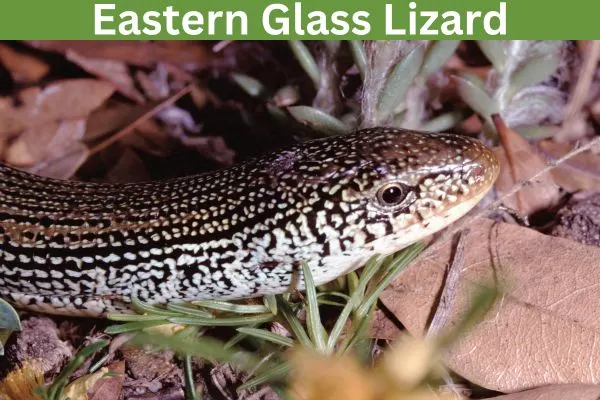
- Experience Level: Intermediate
- Family: Anguidae
- Scientific Name: Ophisaurus ventralis
- Other Names: n/a
- Adult Size: 18 to 43 in. (46 to 108 cm.)
- Lifespan: 10 to 30 years
- Average Price Range: $50
In Louisiana, the eastern glass lizard has only been documented in a few southern counties within the state. This lizard is mainly found in the southeastern United States. While not endangered, in Louisiana this species is rare, as it has an extremely low population.
Eastern glass lizards have long, and slender bodies, with no legs. They have a tan, light brown, green, or yellow coloring, with a glossy appearance. Unlike snakes, glass lizards have an eardrum and blinkable eyes.
Summer is when this species mates, and they lay their eggs under things like logs, or in leaf litter. Females stay with their eggs until they hatch later in the summer.
Eastern glass lizards vary in size, like their prey. This lizard eats prey like small insects, spiders, and other things that will fit into its mouth.
5. Prairie Lizard

- Experience Level: Intermediate
- Family: Phrynosomatidae
- Scientific Name: Sceloporus consobrinus
- Other Names: Southern Prairie Lizard
- Adult Size: 4 to 7 in. (10.16 to 17.78 cm.)
- Lifespan: n/a
- Average Price Range: n/a
The prairie lizard is a species found in most of Louisiana but is not seen in the southern portions of the state. Prairie lizards are seen in grasslands and other habitats with sparse vegetation. This lizard is diurnal, but they typically avoid the hit times of the day.
The prairie lizard has a light brown to gray coloring. They have roughly keeled scales, with stripes running across their bodies. Other tan and white markings appear on them, and their coloring helps them blend into rocky areas. Males in the mating season have blue bellies and necks and are very territorial.
Late spring and summer is the breeding season for this species. Females lay between 4 to 17 eggs, and place them in a dark environment. Here eggs are covered with dirt, and babies begin to hatch in the early fall after incubation.
Prairie lizards feed on insects, and small invertebrates they find. Predatory birds and mammals are a few of these lizard predators. This lizard is not uncommon, and their populations are stable.
6. Texas Horned Lizard
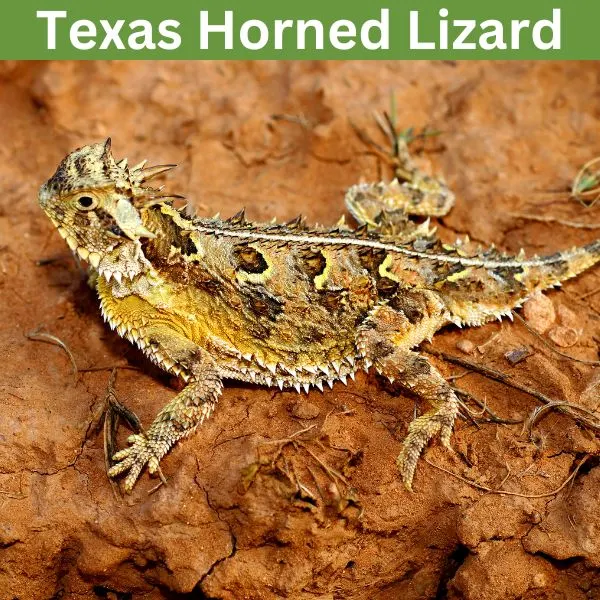
- Experience Level: Advanced
- Family: Phrynosomatidae
- Scientific Name: Phrynosoma cornutum
- Other Names: Horny Toad
- Adult Size: 3.7 to 5 in. (9.93 ot 12.7 cm.)
- Lifespan: 5 years
- Average Price Range: $40
The Texas horned lizard is mainly found in Texas, but this species is sometimes seen in Louisiana. They prefer semiarid open habitats and have been spotted in the far northwestern corner of the state. Texas horned lizards are very spiky, and their spines help them blend into areas with sparse vegetation.
Horns come out of this species’ heads, and their bodies are covered in spikes. Their bellies are round, and overall this lizard is medium-sized. Tan to grayish is the coloring of this species. Their unique appearance helps them blend into their environment.
Amazingly, the Texas horned lizard is able to squirt blood from its eyes which helps them defend itself from predators. Snakes, birds, coyotes, and cats are some of this species’ predators. Their spikes also help them become less palatable but are not dangerous.
7. Little Brown Skink
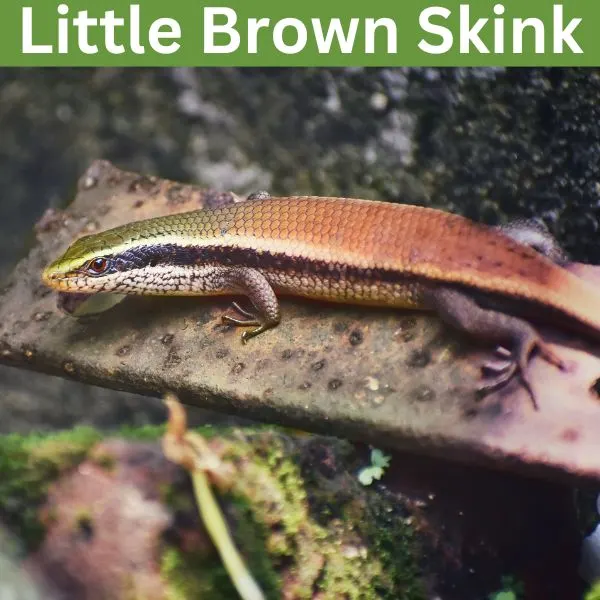
- Experience Level: Beginner
- Family: Scincidae
- Scientific Name: Scincella lateralis
- Other Names: Ground Skink, Brown-backed Skink
- Adult Size: 3 to 5.25 in. (7.62 to 13.3 cm.)
- Lifespan: 2.5 years
- Average Price Range: $5
The little brown skink is found across the southeastern United States. In Louisiana, they can be encountered across the state. Little brown skinks spend their time on the ground and are terrestrial. They burrow into loose dirt or leaves. This species is fossorial, and active during the day. In the colder months of the year they hibernate, and stay underground.
The little brown skink is one of the smallest lizards where it lives. They are named after their tan coloring and have a white, or yellow underside. This species is lengthy, with tiny limbs.
Spiders, insects, and isopods found in the soil are what the little brown skinks eat. They face predators like larger lizards, birds, and larger spiders in the wild, at risk due to their size. Hiding in soil, and leaf litter, and using camouflage help them stay safe. Like other lizards, if attacked, little brown skins can drop their tail to help them escape.
8. Southern Coal Skink

- Experience Level: Intermediate
- Family: Scincidae
- Scientific Name: Plestiodon a. anthracinus
- Other Names: n/a
- Adult Size: 5.1 to 7.1 in. (13 to 18 cm.)
- Lifespan: 6 years
- Average Price Range: n/a
The southern coal skink is the only coal skink subspecies that inhabit Louisiana. Coal skinks are not seen often, and are secretive. They hide under debris like logs, and leaf piles when not active. Coal skinks have been identified in Louisiana in various northern counties within the state.
The southern coal skink appears in tan, brown, or black coloring. They may have a stripe on their side either brown or black. When born this species has a blue tail, which may fade as they age.
Southern coal skinks are terrestrial and feed on animals they find on the ground. This species is active most in the summer months when they breed. Wooded hillsides, valleys, and near springs are some types of habitats this species lives in.
9. Common Five-lined Skink
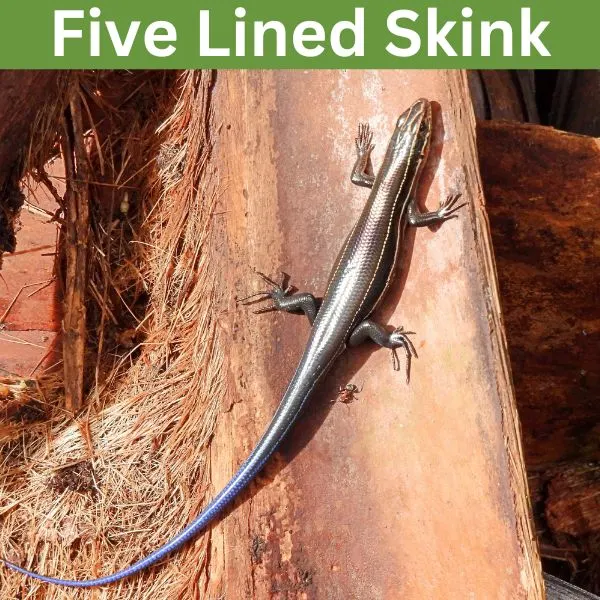
- Experience Level: Intermediate
- Family: Scincidae
- Scientific Name: Plestiodon fasciatus
- Other Names: American Skink
- Adult Size: 4.9 to 8.5 in. (12.5 to 21.5 cm)
- Lifespan: 6 years
- Average Price Range: $12
The common five-lined skink is native to the southeastern United States. This lizard is widespread and is one of the few lizards in Louisiana found statewide. Common-five lined skinks live in woodlands and rocky habitats near water sources. Spring through fall is when they are sighted most, and they become inactive in the summer.
When born, common five-lined skinks have blue tails, which fade as they age. They are darkly colored and are named after the five lines that cover their back. Males in the breeding season have reddish or yellow coloring on their cheeks.
Common five-lined skinks are very common in their range. Their diet consists of animals like spiders, beetles, and even fruit or vegetables. Because of how common they are, this skink is commonly kept as a pet. Laws vary based on location determining if this species, and how many can be captured in the wild.
10. Southeastern Five-lined Skink
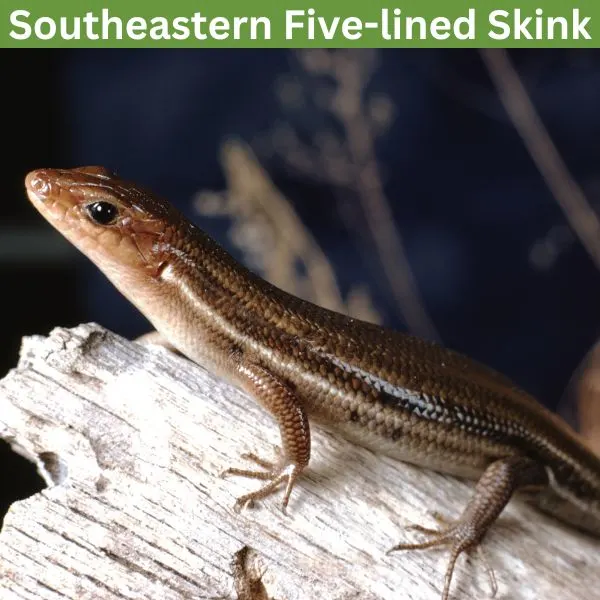
- Experience Level: Beginner
- Family: Scincidae
- Scientific Name: Plestiodon inexpectatus
- Other Names: n/a
- Adult Size: 5.5 to 8.5 in. (13.97 to 21.59 cm.)
- Lifespan: 6 years
- Average Price Range: n/a
The southeastern five-lined skink is found in the southeastern United States, including Louisiana. This species is not common in the state and has generally only been seen in the eastern portion. As a very active species, they can be spotted on the ground or in the trees.
Southeastern five-lined skinks are a medium-sized species and are some of the larger ones in the state. This species can have gray, brown, or black coloring. They have stripes that run down their body, and when young a blue tail. Males sometimes get markings on their faces.
If spotted this species will likely flee, and their speed makes them difficult to capture. Southeastern five-lined skins feed on insects, spiders, and invertebrates. When not active they hide under debris like logs or leaves.
11. Broadhead Skink

- Experience Level: Intermediate
- Family: Scincidae
- Scientific Name: Plestiodon laticeps
- Other Names: Broadhead Skink, Red-headed Scorpion
- Adult Size: 5.9 to 13 in. (15 to 33 cm.)
- Lifespan: 4 to 8 years
- Average Price Range: n/a
The broadhead skink is one of the lizards found in Louisiana. This species inhabits the southeastern United States. They prefer habitats with lots of trees. Broadhead skinks are seen in the trees, or on the ground. Broadhead skins are active during the day, spending their time hunting, and basking in the sun.
This skink is named after its larger head. They are medium-sized and are one of the largest skinks native to the southeast United States. Broadhead skinks are gray or brown when mature. Young specimens have blue coloring on their tail and may have stripes running down their body.
Insects, spiders, and small invertebrates are what this species eats. Their blue tails increase their chances of survival, as their tails are detachable, and their color helps prevent animals from attacking their vital spots.
12. Prairie Skink

- Experience Level: Intermediate
- Family: Scincidae
- Scientific Name: Plestiodon septentrionalis
- Other Names: n/a
- Adult Size: 5 to 9 in. (13 to 22 cm.)
- Lifespan: 10 years
- Average Price Range: n/a
In Louisiana, the prairie skinks range covers the northwestern corner of the state. They live in sandy habitats or grasslands with loose soil. Prairie skinks get their name since they are native lizard east of the Rocky Mountains. The population of this lizard is considered stable, and they are listed by the IUCN as a species of least concern.
Adults have brown, or tan coloring. When young this lizard like other skinks has bright blue tails, which go away with age. Prairie skinks may have white, or dark tan stripes running down their body.
During the cold part of the year this lizard will burrow, and hibernate underground. When active they spend their time hunting animals like ants, spiders, crickets, and other small invertebrates. Prairie skinks face predators like owls, snakes, raccoons, and small rodents.
13. Spotted House Gecko

- Experience Level: Intermediate
- Family: Gekkonidae
- Scientific Name: Hemidactylus parvimaculatus
- Other Names: Sri Lankan House Gecko
- Adult Size: 3 to 6 in. (7.62 to 15.24 cm.)
- Lifespan: 7 years
- Average Price Range: n/a
The spotted house gecko is one of the two types of gecko lizards that live in Louisiana. While not native to the state, the spotted house gecko has been introduced to a small region in New Orleans, likely due to trading. This species is native to the Malay Peninsula.
Spotted house geckos have gray, to tan coloring. They are covered in dark blotches and have bumpy skin. This lizard has a pinkish belly. Their eyes are large, and help them track down prey when hunting at night. In their natural habitat, this species has been seen eating frogs, and bugs.
14. Mediterranean House Gecko
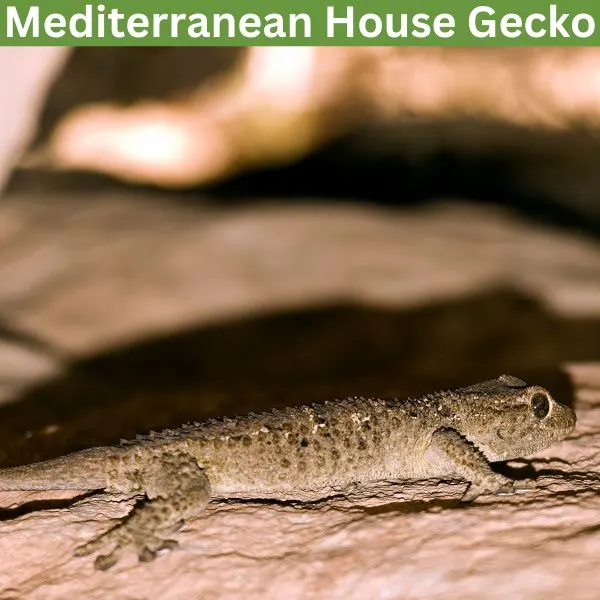
- Experience Level: Beginners
- Family: Gekkonidae
- Scientific Name: Hemidactylus turcicus
- Other Names: Moon Lizard, Turkish Gecko
- Adult Size: 4 to 5 in. (10 to 13 cm.)
- Lifespan: 3 to 9 years
- Average Price Range: $10
The Mediterranean house gecko is not native to Louisiana, or any other parts of the United States. This lizard is native to the Mediterranean regions of Europe. It is believed these geckos managed to find their way into the state through cargo trade. Caves, rocky areas, salt marshes, and inside secluded areas of homes are common places this species lives.
Medium-sized, the Mediterranean house gecko has a tan, to purplish skin. They have large eyes with cat-like pupils. The Mediterranean house gecko may have spots and brown blotches on their body. Their skin is very bumpy, and their tails are thick.
This lizard is active at night and spends this time hunting insects like grasshoppers, roaches, beetles, moths, and ants. The Mediterranean house gecko is sometimes seen together in groups, and during the day they hide under rocks or stones.
15. Six-lined racerunner
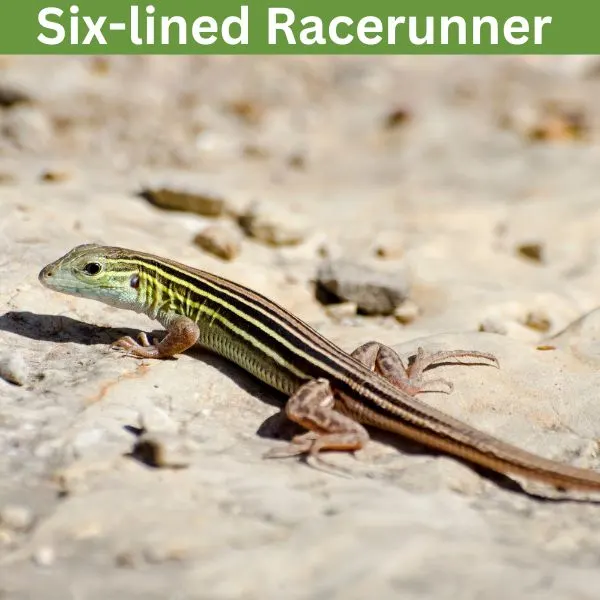
- Experience Level: Intermediate
- Family: Teiidae
- Scientific Name: Aspidoscelis sexlineata
- Other Names: Sandlapper lizard
- Adult Size: 6 to 9.5 in. (15 to 24 cm.)
- Lifespan: 4 to 5 years
- Average Price Range: $30
Six-lined racerunners are seen in most of western Louisiana. This species’ range covers the far southeastern United States. Woodlands, fields, and open habitats are some of the areas this lizard lives. The daytime is when this species can be spotted, dashing around through vegetation.
Dark green, brown, or black are the common colors this species comes in. They have a white underside, but males may have blue ones. Stripes that are yellow, or greenish run across this lizard’s back.
Active in the day, six-lined racerunners spend their time looking for insects to feed on. They are very quick, and if spotted will likely flee. Six-lined racerunners are seen most in the summer and spring months, which is when they breed, and lay their eggs.
FAQ
What is the most common lizard in Louisiana?
There are 15 lizard species that live in Louisiana, and the green anole is one of the most common species in the state. They are the only native anole lizard that lives in Louisiana, while the brown anole has been introduced. Forests and urban areas are where this lizard is often found.
What is the biggest lizard in Louisiana?
Glass lizards are the largest lizard species that lives in Louisiana. They are legless, with snake-like bodies that reach up to 46 in. Broadhead skinks are also a large species many find in the state and are one of the biggest lizards in the southeast of the country. Sex, age, diet, and species are important factors in determining how large a lizard gets.
Are lizards in Louisiana dangerous?
The lizards in Louisiana are harmless to humans, and they are also not dangerous to smaller animals or pets. Despite some lizards’ bright colors, the ones that live in Louisiana are not poisonous, or venomous. While lizards can bite and can spread dangerous germs, they are not typically a threat to humans.
Wrapping up
There are around 15 lizard species that live in Louisiana, and they help keep a balance in the state’s various ecosystems. They are used as food by animals like hawks or skunks, and lizards also help control invertebrate populations.
Hopefully, this list is helpful in helping you learn about, and identify any lizards in Louisiana. Lizards are just a few of the wildlife that is abundant in the United States. Knowing what lizards look like, where they are found, and their behaviors are some of the ways to find and identify lizards in the wild.
More lizards in other nearby states
